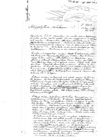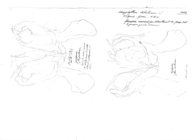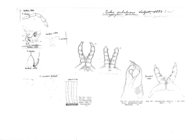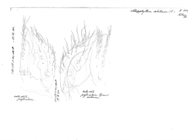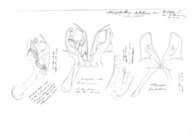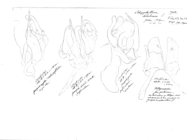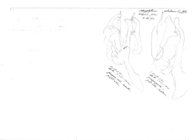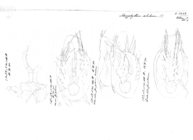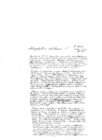
| Introduction | | Pauropoda | | Symphyla | | Chilopoda | | Diplopoda | | Literature | | Images | | Log in |
Myriapods taxon detailsOmmatoiulus sabulosus (Linnaeus, 1758)
151195 (urn:lsid:marinespecies.org:taxname:151195)
accepted
Species
terrestrial
Linnaeus, C. (1758). Systema Naturae per regna tria naturae, secundum classes, ordines, genera, species, cum characteribus, differentiis, synonymis, locis. [The system of nature through the three kingdoms of nature, according to classes, orders, genera, species, with characters, differences, synonyms, places.]. <em>Impensis Direct. Laurentii Salvii. Holmiae [Stockholm].</em> 1(10) [iii], 824 p., available online at https://biodiversitylibrary.org/page/726886
page(s): 640 [details] Available for editors (of ) Linnaeus, C. (1758). Systema Naturae per regna tria naturae, secundum classes, ordines, genera, species, cum characteribus, differentiis, synonymis, locis. [The system of nature through the three kingdoms of nature, according to classes, orders, genera, species, with characters, differences, synonyms, places.]. <em>Impensis Direct. Laurentii Salvii. Holmiae [Stockholm].</em> 1(10) [iii], 824 p., available online at https://biodiversitylibrary.org/page/726886 [details] Available for editors
Myriapods (2021). Ommatoiulus sabulosus (Linnaeus, 1758). Accessed at: http://www.marinespecies.org/myriapoda/aphia.php?p=taxdetails&id=151195 on 2025-05-04
original description
Linnaeus, C. (1758). Systema Naturae per regna tria naturae, secundum classes, ordines, genera, species, cum characteribus, differentiis, synonymis, locis. [The system of nature through the three kingdoms of nature, according to classes, orders, genera, species, with characters, differences, synonyms, places.]. <em>Impensis Direct. Laurentii Salvii. Holmiae [Stockholm].</em> 1(10) [iii], 824 p., available online at https://biodiversitylibrary.org/page/726886
page(s): 640 [details] Available for editors original description (of ) Linnaeus, C. (1758). Systema Naturae per regna tria naturae, secundum classes, ordines, genera, species, cum characteribus, differentiis, synonymis, locis. [The system of nature through the three kingdoms of nature, according to classes, orders, genera, species, with characters, differences, synonyms, places.]. <em>Impensis Direct. Laurentii Salvii. Holmiae [Stockholm].</em> 1(10) [iii], 824 p., available online at https://biodiversitylibrary.org/page/726886 [details] Available for editors basis of record Hayward, P.J. & J.S. Ryland (Eds.). (1990). The marine fauna of the British Isles and North-West Europe: 1. Introduction and protozoans to arthropods. <em>Clarendon Press: Oxford, UK.</em> 627 pp. (look up in IMIS) [details] Available for editors additional source Risso, A. (1826-1827). Histoire naturelle des principales productions de l'Europe Méridionale et particulièrement de celles des environs de Nice et des Alpes Maritimes. <em>[book series].</em> 400 pp., 13 pls. [volumes 1-5. Paris, F.G. Levrault. vol. 3. Mammifères. Oiseaux. Poissons / vol. 4. Mollusques. Annélides / vol. 5. Crustacés. Myriapodes, scorpionides, arachnides et acarides. Insectes. Vers intestinaux. Radiaires. Zoophytes]., available online at http://www.biodiversitylibrary.org/bibliography/58984 page(s): 149 [details] additional source Blower, J.G. (1985) Millipedes. Linnean Society Synopses of the British Fauna (New Series) 35. E.J.Brill/Dr W.Backhuys, London, Leiden, Koln, Kobenhavn. [details] additional source Lee, P. (2006) Atlas of the Millipedes (Diplopoda) of Britain and Ireland. Pensoft, Sofia-Moscow [details] additional source Kime, R.D. (1999) The continental distribution of some British and Irish Millipedes. Bull.Brit.Myriapod Gp. 15:33-76 [details] additional source Lucas, H. (1840). Histoire Naturelle des Crustacés, des Arachnides et des Myriapodes. <em>P. Duménil, Paris.</em> 600 pp. + 46 plates (inclusive)., available online at http://biodiversitylibrary.org/page/30739516 page(s): 530 [details] additional source Strasser, K. (1978). Diplopodi del Piemonte. Bollettino del musei civico di storia naturale di Verona, 5: 141-173. Verona page(s): 168 [details] additional source Tischler, W. (1980). Asseln (Isopoda) und Tausendfüßer (Myriopoda) eines Stadtparks im Vergleich mit der Umgebung der Stadt. Drosera, 80: 41-52. Oldenburg page(s): 44 [details] additional source Ceuca, T. (1992). Quelques aspects sur la faunistique l'écologie et la zoogeographie des diplopodes de la Région Balkanique. Bericht des naturwissenschaftlich-medizinischen Vereins in Innsbruck, Supplementum, 411-429. Innsbruck page(s): 426 [details] additional source Jawlowski, H. (1930). Uwagi o niektórych gatunkach rodzaju Leptoiulus Verh., wraz z opisemkilu nowych form z poludniowej Polski. Bemerkungen über einige Arten der Gattung Leptoiulus Verh., nebst Beschreibung einiger neuen Formen aus Süd-Polen. Annales Musei Zoologici Polonici, 9(3): 21-28. Warszawa page(s): 75 [details] additional source Kurnik, I.; Thaler, K. (1985). Weitere Diplopoden-Fallenfänge in Nordtirol (Österreich) (Myriapoda: Diplopoda). Bericht des naturwissenschaftlich-medizinischen Vereins in Innsbruck, 72: 145-154. Innsbruck page(s): 145 [details] additional source Latzel, R. (1884). Die Myriopoden der Österreichisch-ungarischen Monarchie. Zweite Hälfte. Die Symphylen, Pauropoden und Diplopoden. 1-414. Wien page(s): 327 [details] additional source Mauriès, J.-P. (1971). Diplopodes épigés et cavernicoles des Pyrénées Espagnoles et des Monts Cantabriques. IV-V. Blaniuides et iulides. Bulletin de la Société d'histoire naturelle de Toulouse, 107: 103-116. Toulouse page(s): 115 [details] additional source Pedroli-Christen, A. (1993). Faunistique des mille-pattes de Suisse (Diplopoda) - Faunistik der Tausendfüssler der Schweiz (Diplopoda). Documenta Faunistica Helvetiae, 14: 1-167, i-lxii. Neuchâtel page(s): 87 [details] additional source Pocock, R. I. (1895). Contributions to the knowledge of the Diplopoda of Liguria. <em>Annali del Museo civico di storia naturale di Genova, serie 2.</em> 14: 505-525., available online at http://biodiversitylibrary.org/page/7940545 page(s): 514 [details] additional source Rothenbühler, H. (1899). Ein Beitrag zur Kenntnis der Myriapodenfauna der Schweiz. Revue suisse de zoologie, 6: 199-271. Genève, available online at https://www.biodiversitylibrary.org/page/10340630 page(s): 259 [details] additional source Thaler, K. (1982). Fragmenta Faunistica Tirolensia - V (Arachnida: Aranei; Crustaceae: Isopoda, Oniscoidea; Myriapoda: Diplopoda; Insecta: Saltatoria). Bericht des naturwissenschaftlich-medizinischen Vereins in Innsbruck, 69: 53-78. Innsbruck page(s): 58 [details] additional source Thaler, K.; Knoflach, B.; Meyer, E. (1993). Fragmenta Faunistica Tirolensia - X (Arachnida, Acari: Caeculidae; Myriapoda: Diplopoda; Insecta, Nematocera: Limoniidae, Sciaridae). Bericht des naturwissenschaftlich-medizinischen Vereins in Innsbruck, 80: 311-325. Innsbruck page(s): 318 [details] additional source Verhoeff, K. W. (1894). Beiträge zur Diplopoden-Fauna Tirols. Verhandlungen der Zoologisch-botanischen Gesellschaft in Wien, 44: 9-34 page(s): 30 [details] additional source Voigtländer, K.; Hauser, H. (1999). Fortschritte in der Kenntnis der Diplopoden der Oberlausitz. Berichte der Naturforschenden Gesellschaft der Oberlausitz, 7-8: 105-117. Görlitz page(s): 108 [details] additional source Foddai, D.; Minelli, A.; Scheller, U.; Zapparoli, M. (1995). Chilopoda, Diplopoda, Pauropoda, Symphyla. In: Minelli, A.; Ruffo, S.; La Posta, S. [Ed.], Checklist delle Specie della Fauna Italiana, 32/33, 1-35. Bologna page(s): 27 [details] additional source Brandt, J. F. (1840). Generis Juli specierum enumeratio, adjectis plurium, quae hucusque nondum innotuerunt specierum brevibus descriptionibus ad Musei Academiae Scientifiarum Petropolitanae specimina factis. Bulletin Scientifique publié par l'Académie Impériale des Sciences de Saint-Pétersbourg, 8(7): 97 -128. St. Petersburg, available online at http://biodiversitylibrary.org/page/44344298 page(s): 101 [details] additional source Gervais, P. (1837). Études pour servir á l'histoire naturelle des Myriapodes. <em>Annales des Sciences naturelles, Zoologie, série 2, tome 7: 35-60, plate 4b.</em> , available online at https://www.biodiversitylibrary.org/page/2254777 page(s): 46 [details] additional source Gervais, P. (1847). Myriapodes. In: Walckenaer, Hist. natur. des Insectes. Aptères IV, 4: 1-623. Paris, available online at http://biodiversitylibrary.org/page/32961491 page(s): 139 [details] additional source Koch, C.L. (1847). Den Verzeichnissen und Berichtigungen zu Deutschlands Crustaceen, Myriapoden und Arachniden und ein System der Myriapoden. [The lists and corrections to Germany's crustaceans, myriapods and arachnids and a system of the myriapods.]. <em>In: Panzer, G.W.F. & Herrich-Schäffer, A. (eds.), Kritische Revision der Insectenfaune Deutschlands.</em> 3: 1-272, pls. 1-10., available online at http://biodiversitylibrary.org/page/33700094 page(s): 112 [details] additional source Newport, G. (1844). A list of the species of Myriapoda, order Chilognatha, contained in the cabinets of the British Museum, with description of a new genus and thirty-two new species. Annals and Magazine of Natural History, 13: 263-270. London page(s): 267 [details] additional source Voigtländer, K.; Düker, C. (2001). Distribution and species grouping of millipedes (Myriapoda, Diplopoda) in dry biotopes in Saxony-Anhalt/Eastern Germany. European Journal of Soil Biology, 37: 325-328, available online at https://doi.org/10.1016/s1164-5563(01)01104-9 page(s): 326 [details] additional source Brandt, J. F. (1833). Tentaminum quorundam monographicorum Insecta Myriapoda Chilognathi Latreillii spectantium prodromus. Bulletin de la Societé Impériale des Naturalistes de Moscou, 6: 194-209. Moscow, available online at http://biodiversitylibrary.org/page/45989137 page(s): 201 [details] additional source Daday, J. (1889). A magyarországi Myriopodák Magánrajza [Myriopoda regni Hungariae]. 1-126. Budapest page(s): 55 [details] additional source Meinert, F. V. A. (1868). Danmarks chilognather. Naturhistorisk Tidskrift, 3. Raekke, 5: 1-32. Kjöbenhavn page(s): 11 [details] additional source Brandt, J. F. (1841). Recueil de mémoires relatifs a l'ordre des Insectes Myriapodes, et lus à l'Académie Impériale des Sciences de St.-Pétersbourg. 1-189. St. Petersburg page(s): 83 [details] additional source Tajovský, K. (2001). Millipedes (Diplopoda) of the Czech Republic. <em>Myriapodologica Czecho-Slovaca.</em> 1: 11-24. page(s): 17; note: citation of species name [details] additional source Stoev, P. E. (2003). Diversity and conservation significance of the centipede (Chilopoda, Diplopoda) in Rila Monastery Nature Park. 134-138. Rila page(s): 136 [details] additional source Voigtländer, K. (2006). Mass occurrences and swarming behaviour of millipedes (Diplopoda: Julidae) in Eastern Germany. Peckiana, 4: 181-187 page(s): 182; note: citation of species name [details] additional source Spelda, J. (2006). Improvements in the knowledge of the myriapod fauna of southern Germany between 1988 and 2005 (Myriapoda: Chilopoda, Diplopoda, Pauropoda, Symphyla). Peckiana, 4 (2005): 101-129 page(s): 106 [details] additional source Leach, W.E. (1816 [1815]). A tabular View of the external Characters of Four Classes of Animals, which Linné arranged under Insecta, with the Distribution of the Genera comprising Three of these Classes into Orders &c. and Descriptions of several New Genera and Species. <em>The Transactions of the Linnean Society of London.</em> 11(2): 306-400., available online at http://biodiversitylibrary.org/page/756873 page(s): 377 [details] additional source Kime, R. D.; Enghoff, H. (2017). Atlas of European millipedes 2: Order Julida (Class Diplopoda). <em>European Journal of Taxonomy.</em> 346: 1–299., available online at https://doi.org/10.5852/ejt.2017.346 page(s): 143 [details] additional source Akkari, N.; Gilgado, J. D.; Ortuño, V. M.; Enghoff, H. (2018). Out of the dark void: Ommatoiulus longicornis n. sp., a new julid from Spain (Diplopoda, Julida) with notes on some troglobiomorphic traits in millipedes. <em>Zootaxa.</em> 4420(3): 415-429., available online at https://doi.org/10.11646/zootaxa.4420.3.7 page(s): table 2 [details] additional source Kocourek, P.; Dolejš, P.; Kovaříková, A. (2023). Atlas rozšíření mnohonožek v České republice / Atlas of the Millipedes of the Czech Republic. page(s): 111-112; note: Detailed distribution data. [details] additional source Haľková, B.; Drabová, M.; Mock, A. (2021). An annotated checklist of millipede fauna from Slovakia, with ecological and biogeographic characteristics. <em>Biodiversity Data Journal.</em> 9., available online at https://doi.org/10.3897/bdj.9.e71495 page(s): 15 [details]  Present Present  Inaccurate Inaccurate  Introduced: alien Introduced: alien  Containing type locality Containing type locality
From editor or global species database
Ecology As well as other habitats, this is characteristic of duneland & often seen in large numbers on the foreshore adjacent to duneland (Blower, 1985) [details]
|
